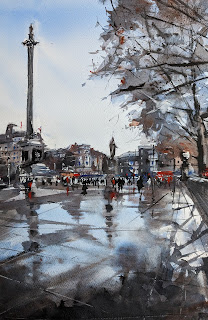As part of Green & Stone’s 'Works on Paper' event earlier this year, we interviewed painter, teacher and writer Sara Lee Roberts. She speaks about the importance of drawing from the Old Masters, her love for the versatility of St Cuthberts Mill Bockingford paper, and her book, ‘Painting and Reinterpreting the Masters’.
I first learnt to paint with oils while sitting next to my father (the artist Dick Lee), in a field in Normandy. I was 7 years old. I have been painting ever since. Early subjects were the French landscape, interiors in a stunning but bare flat in Paris where I lived for 2 years, and still live. I studied at the Byam Shore School of Art, then at Sussex University where I trained as a Physicist and at Cambridge University where I trained as a Paintings Conservator. I have restored paintings in the Wallace Collection, the Royal Collection and the National Trust Collection. This work gave me an understanding of the old Masters techniques but also allowed me to see them as working artists, like myself, rather than putting them on a pedestal. In my current work, I reference the art of the past, but this is almost hidden as I move towards greater abstraction. The quality that I most want is that of light - not light that is described, but rather light that emanates from the colours and shapes on my canvas.
I believe that drawing is fundamental to an art practice as it helps us to be honest about what we see and what we make. Drawing has to be done almost every day as it is a skill that has to be kept alive and fresh. Increasingly I notice that drawing can express a love of the materials that we use as well as referencing external subjects. I usually draw with charcoal, but the particular feel of the individual charcoal stick and the colour and texture of the paper are crucial.
What is your go-to drawing paper to use and why?
I like paper that is fairly smooth and not too bright a white. Recently I have been working on sheets of St Cuthberts Mill’s Bockingford Hot Pressed. I like to use this for watercolour and gouache, as well as for charcoal drawings. I stretch it when I use water based materials. It can also be used, when stretched and gessoed for oil painting. I also keep a sketchbook on the go.
You’ve written a book called ‘Painting and Reinterpreting the Masters’ – what is the importance of learning from and responding to the works of the masters?
We are all part of a continuum - everyone has thought themselves to be contemporary during their life! We are influenced by all the shapes and colours around us and have been either directly or indirectly affected by art of the past. I work from the Old Masters partly to learn about quality, composition, colour and rhythm, but also to remind myself that I can stand up to them - that by copying and then (crucially) rebelling/asserting myself I learn in what way I am different from them. I have a feeling of both love and defiance when I draw from the masters.
Thumbnail sketches can be made very fast and with a minimum of detail. You are forced to see, understand and show only the larger and most important underlying shapes that hold the composition together. This practise means that your own work will naturally be held by strong underlying shapes (abstraction) rather than be a piecemeal putting together of bits and pieces of detail. Larger drawings from the masters help you to feel more confident and equal to the master, but are best done after several thumbnail sketches have been made. Another positive about thumbnails is that they can be made discreetly in a gallery or museum as all you need is a tiny sketchbook and pencil - and afterwards you will remember that painting well. It's a far more useful interaction with art than just standing and staring. Oil sketch copies are a way to understand the colour relationships in a master work without getting into imitating the technique - and these also can be made small and fast.
 Are there specific artists or art movements that you’ve found particularly influential or inspiring in your practice?
Are there specific artists or art movements that you’ve found particularly influential or inspiring in your practice? I take from everywhere. I do not rule anyone out. Their art, once made, has a life of its own. I look at as much contemporary art as I do at the Old Masters. I also read the writings of artists - these are far more useful than anything that art historians or critics write. I am particularly interested in Eugene Delacroix's journals, in Philip Guston’s writings and in Agnes Martin's writings. Beaudelaire and Rilke are poets who wrote wonderful essays on art. Increasingly I am interested in the relationship between painting and poetry.
Find out more about Sara Lee Roberts:
www.instagram.com/saraleerobertsart/
For more information on the Green & Stone 'Works on Paper' exhibition, including the catalogue, visit:
https://www.thegalleryatgreenandstone.com/winter-exhibition-2024
To learn more about the Bockingford range visit our website.
Article originated by The Gallery at Green & Stone, as part of their 'Works on Paper' exhibition. Our thanks to them for allowing us to replicate the piece.




















.jpg)


































